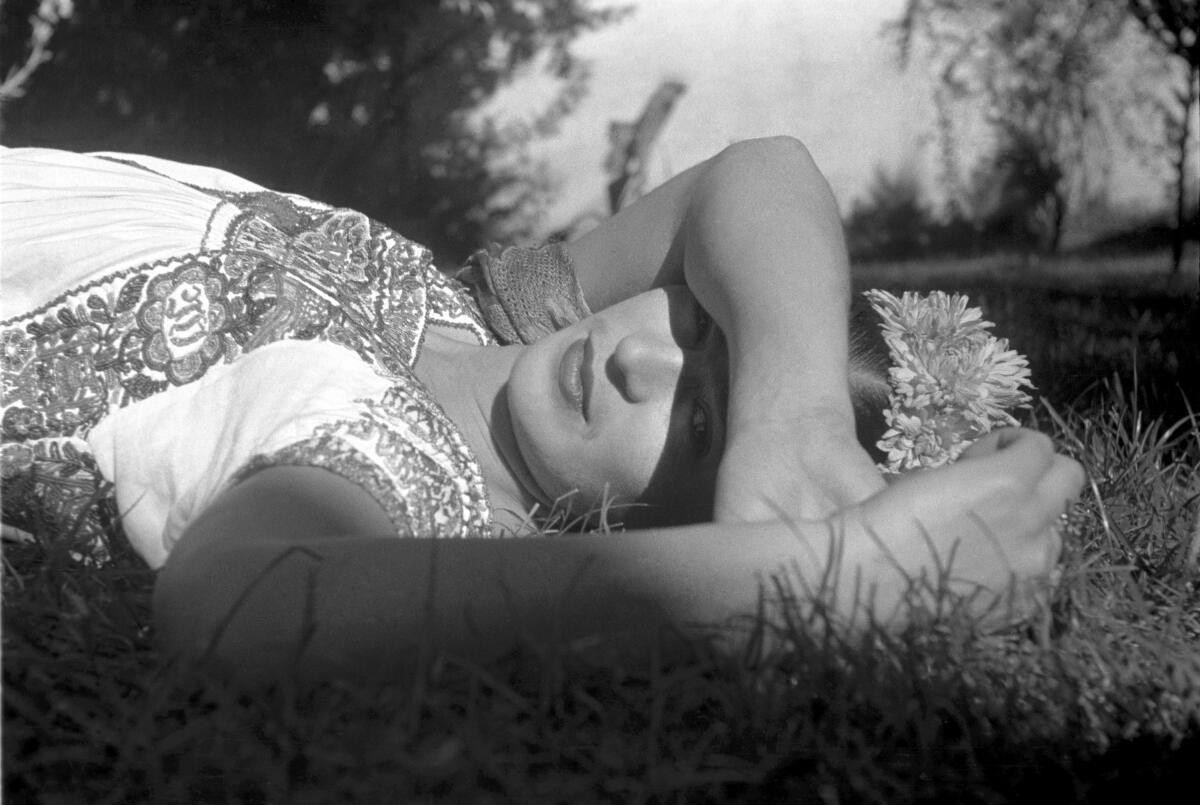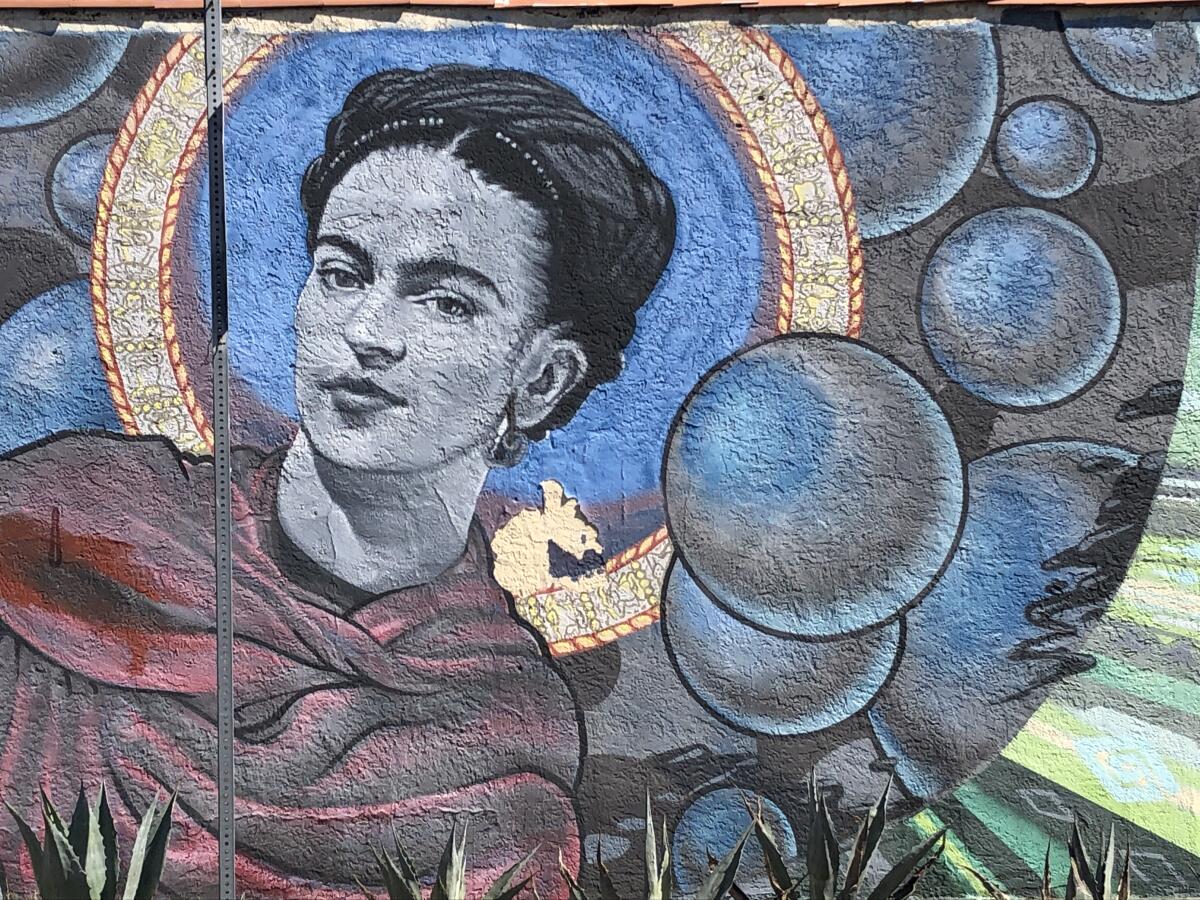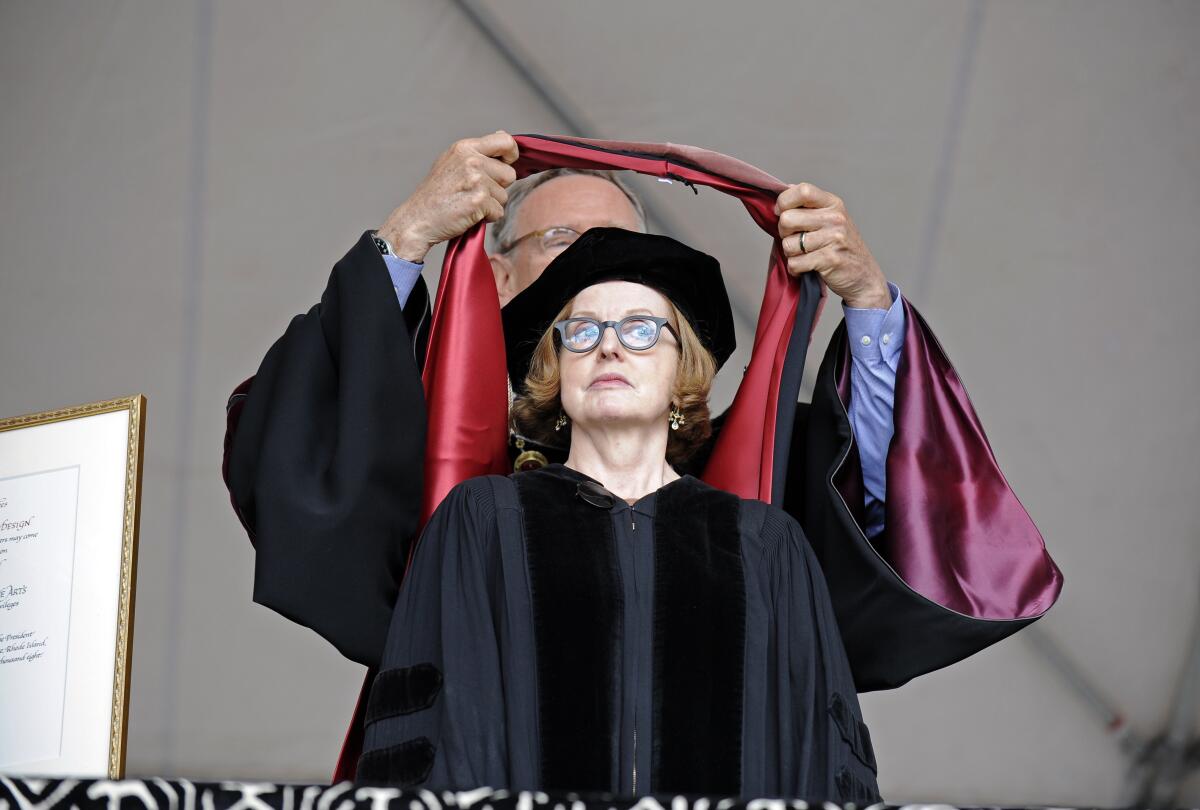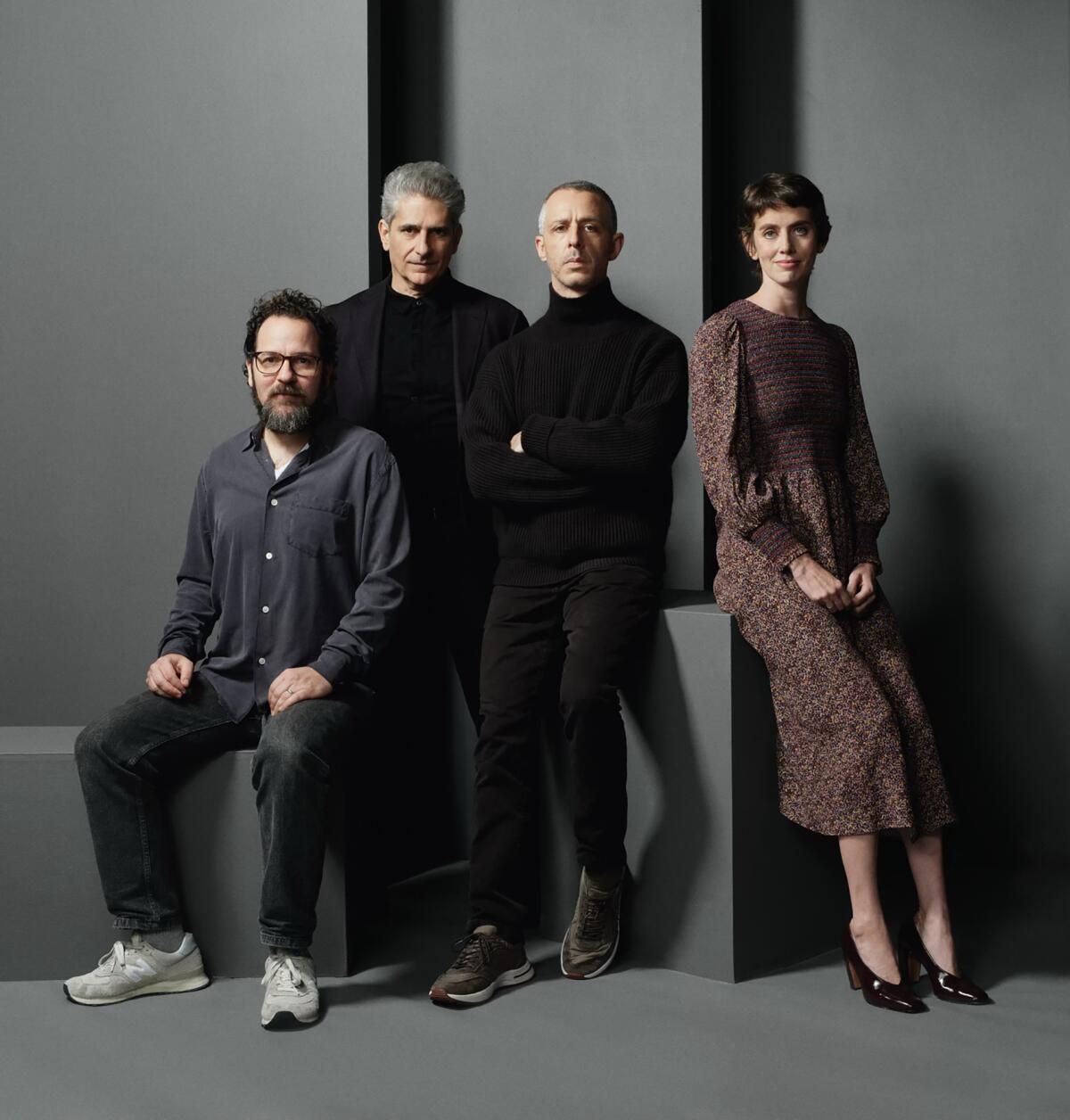Frida Kahlo’s story has been told and retold. A new doc captures the voice of the Mexican painter

- Share via
It’s the weekend and I’m dreaming about sushi from Waka Sakura in Gardena. I’m Carolina A. Miranda, art and design columnist at the Los Angeles Times, with all the raw fish and essential arts news:
A new take on Frida
Is it possible to know any more about Frida Kahlo than we already do? The 20th century Mexican painter placed her tumultuous life and her bodily pains on her canvases. Her husband, muralist Diego Rivera, incorporated her visage into some of his most famous murals. She was photographed relentlessly, even appearing in Vogue. And that was just in her lifetime. (Kahlo died in 1954 at the age of 47.)
Since then, she has been depicted in feature films by Mexican actors Ofelia Medina and Salma Hayek (in 1983 and 2002, respectively), as well as in documentaries — most recently in director Louise Lockwood’s three-part series “Becoming Frida Kahlo.” She is also the subject of countless murals and other art. In Mexico City in 2016, I saw a fascinating installation by artist Juan Acha at the Museo de Arte Moderno that examined the ways in which Kahlo’s 1939 canvas “Las Dos Fridas” has been copied by fellow artists and appropriated by popular culture.
Kahlo’s work and her image also have generated endless mountains of merch (also addressed in Acha’s installation). Currently sitting on my desk is a stack of Frida Kahlo-branded cosmetics I acquired at Walgreens several years ago — objects in search of an essay.

All of this means that Peruvian-born director Carla Gutiérrez’s new documentary, “Frida,” which landed this week on Prime Video, is entering a crowded field. Clocking in at almost 90 minutes, the doc provides a cursory overview of this well-chronicled artist. Certainly, the story of Kahlo could fill a set of encyclopedias: She came of age in the wake of the Mexican Revolution, was inspired by its mission to rethink the essence of Mexican culture, counted Isamu Noguchi and Leon Trotsky among her lovers and produced groundbreaking paintings, inspired by folk traditions, that depict the devastations of womanhood. (Hayden Herrera’s famous biography is more than 500 pages long.)
Like many Kahlo projects, Gutiérrez’s storyline rests on the broad narrative arc of Kahlo’s life. (If you’ve read Herrera’s biography, you’re probably not going to learn much.) But the film manages to stand out on a few fronts. For one, there are no awkward reenactments and no talking heads. Visuals consist exclusively of a mix of vintage footage and photography, along with Kahlo’s diaristic drawings and paintings — some of which are animated for added effect. Animating a painting can be cloying. (Can we let painting be painting?) But the filmmaker approaches her work with reverence. And the structure of the narrative, which centers Kahlo’s voice, drawn from her letters and diaries, makes the enterprise worthwhile.

Often translations of Kahlo’s writings soften her language. But “Frida” lets Kahlo be Kahlo. She calls Rivera “la gran caca” (the big s—) and describes wanting to be “f—” by a school crush. She trash-talks the French Surrealists and expresses profound disgust with the Depression-era United States. “I am completely disappointed with the famous United States,” she declares. “Everything here is about appearances, but deep down it’s truly s—. I’ve seen thousands of people in the most terrible conditions, without anything to eat or anywhere to sleep.”
The narration, wonderfully performed by Fernanda Echevarría del Rivero, captures the musicality of Mexican Spanish — as well as Kahlo’s irreverent personality. It’s a nice break from the often-depicted long-suffering martyr.
You’re reading Essential Arts
Our critics and reporters guide you through events and happenings of L.A.
You may occasionally receive promotional content from the Los Angeles Times.
If you’re dipping a toe into the world of Kahlo, “Frida” is a good introductory work. But if you want something deeper, I recommend turning to Lockwood’s docuseries “Becoming Frida Kahlo,” which aired on PBS last fall.
The documentary tracks down key players: biographer Herrera, along with historians Martha Zamora and Luis-Martín Lozano, Kahlo’s great-niece Cristina Kahlo and Rivera’s grandson Juan Coronel Rivera. In addition to Kahlo’s life, the series explores the artist’s influences, which include the politics of the era, as well as important female artists such as photographer Tina Modotti. (If you want to keep going down the rabbit hole, British film theorists Laura Mulvey and Peter Wollen made an interesting, impressionistic short film in 1983 that compared the work of Kahlo and Modotti — including their interest in the matriarchal societies of Tehuantepec.)
But altogether, these documentaries show that there is always room for more — namely, a deeper exploration of Kahlo’s art, its roots and its resonances. Kahlo makes for an absorbing narrative, but just as fascinating is the social and political context that produced her — including complex racial politics that mythologized Indigeneity while also subsuming it to a broader mestizo culture. Kahlo’s story has been told and retold, but there are still pieces left to divulge.
“Frida” is now screening on Prime Video.
Musical chairs
There are so many big personnel moves in the world of fine arts this week, it’s hard to keep up with them all!
Here in SoCal, L.A. Opera announced that music director James Conlon will step down after the 2025-26 season. “I have a lot of energy left, a lot of passion left,” Conlon tells The Times’ Jessica Gelt. “And there are other things that I feel I have wanted to do and I just can’t.” His departure will coincide with that of the L.A. Phil’s Gustavo Dudamel — marking a sea change for classical music in the city.

In the Bay Area, the big news is that Esa-Pekka Salonen is stepping down as music director of the San Francisco Symphony in 2025. In a statement to KQED, Salonen said he was leaving because “I do not share the same goals for the future of the institution as the Board of Governors.”
Joshua Kosman, classical music critic at the San Francisco Chronicle, theorizes that the COVID-19 pandemic put a dent in Salonen’s plans for the orchestra — turning what should have been a time of reinvention into one of survival — and he nods to the conductor’s tensions with the board. “Yet in spite of everything,” he writes, “the Salonen years have been a glorious time for Symphony audiences, full of musical adventure, discovery and luxurious execution.”
Meanwhile on the Right Coast...
Roberta Smith, the venerable co-chief art critic at the New York Times, has announced her retirement after 32 years at the paper. Over her tenure, she authored some 4,500 reviews and essays and was the first woman to hold the title of chief art critic. “In my coals-to-Newcastle-life,” Smith stated in an Instagram post, “I will have more time to pursue my number one interest, which is going to galleries and museums, looking at stuff.” Hyperallergic’s Valentina Di Liscia spotlights some of her career highlights.

Tina Rivers Ryan, a curator who specialized in digital art at the Buffalo AKG Art Museum, was named the top editor at Artforum. This follows a period of turmoil after editor in chief David Velasco was fired for publishing an open letter in support of the Palestinian cause.
Performing arts
Times theater critic Charles McNulty writes that there are few plays more appropriate for our pandemic age than Henrik Ibsen’s “An Enemy of the People.” Written in 1882, the story about a doctor-turned-whistleblower has been surfacing a lot as of late. It was recently reimagined by Theater of War Productions and Amy Herzog has written her own adaptation, which will soon premiere on Broadway. “The central conflict of ‘An Enemy of the People’ resonates in manifold ways today,” writes McNulty, “from the water crisis in Flint, Mich., to the political demonization of public health experts during the COVID-19 pandemic to the MAGA Republican effort to undermine truth itself.”

“The Last Repair Shop” is a remarkable, inspiring doc about the craftspeople who maintain the musical instruments for LAUSD — and on Sunday it won the Academy Award for documentary short. This marks the first-ever Oscar win for The Times, which produced the film. (!!!) Jazz critic Nate Chinen, who writes “The Gig,” has a great piece on the doc — and what it represents for co-director Kris Bowers, a jazz pianist and composer.
Do not miss this gorgeous little film. Watch “The Last Repair Shop” here.
In and out of the galleries
In 2020, Elizabeth Alexander launched the Monuments Project at the Mellon Foundation to help preserve and recontextualize monuments — as well as remove them when communities no longer deem them appropriate. This has resulted not just in a shift in the histories honored, but in what is considered a monument to begin with. “There are so many ways we mark spaces to tell stories,” says Alexander. A monument could be a boulder. It could also be a book.

Speaking of monuments, this story about clashes over an anti-abortion monument in Arkansas is all kinds of bananas.
Jori Finkel has an interesting article in the Art Newspaper about a new show of Jean-Michel Basquiat’s work at Gagosian that focuses on the years that the artist spent in L.A.
Have you seen mysterious images of pink sheep around Los Angeles? Over on De Los, reporter Steven Vargas profiles artist Ricky Sencion — a.k.a. Little Ricky — who was inspired to paste them around the city after reading a quote by designer Alexander McQueen.
Design time
My colleague Lisa Boone looks into the latest in ADU design: a tight, 300-square-foot unit, tucked above a garage, by architects Jefferson Schierbeek and Su Addison, that make the most of smart storage areas, high ceilings and strategically placed windows.
Enjoying this newsletter? Consider subscribing to the Los Angeles Times
Your support helps us deliver the news that matters most. Become a subscriber.
A building by architect Samuel Tilden Norton, designer of the Wilshire Boulevard Temple, is under threat of demolition. This week, the L.A. City Council voted to allow the destruction of the B’nai B’rith Lodge, completed in 1924, a Jewish landmark that later became an important organizing center for various labor unions. Preservationists and community advocates are urging Catholic Charities, which now owns the building, to repair and reuse it. The Times’ Angie Orellana Hernandez has the details.

Student art on the Vegas Sphere? The entity that manages the Sphere has announced a design competition for students of the Clark County School District and the University of Nevada, Las Vegas.
Moves
In more Esa-Pekka Salonen news, the San Francisco Symphony music director has won the Polar Music Prize.
Barry Hughson, of the National Ballet of Canada, is the new executive director of American Ballet Theater in New York.
Elizabeth C. Babcock has been named the inaugural director of the Smithsonian American Women’s History Museum in Washington, D.C. She is currently the CEO and president of Forever Balboa Park in San Diego.
Dalila Scruggs has joined the Smithsonian American Art Museum as the museum’s first curator of African American art.
Passages
Edward Bond, a British playwright known for unsparing work depicting rage and violence, whose 1965 play “Saved” led to the end of British theatrical censorship, has died at 89.
Lynn Fainchtein, who served as music supervisor on important Mexican films such as Alejandro González Iñárritu’s “Amores Perros” and Alfonso Cuaron’s “Roma,” is dead at 61.
In the news
— I’m very into photographer Fujio Kito’s Tumblr of Japanese playgrounds at night.
— I’m also into this episode of the “Critics at Large” podcast about fictions set in the workplace. I’d add Netflix’s darkly hilarious “Carol & the End of the World” to their list, which is all about using office mundanity to while away time until an inevitable apocalypse.
— Edward Zitron has an interesting essay on AI and the “Habsburg” internet, where originality goes to die.
— A new study of Indigenous cave art in Puerto Rico shows that it is much older than previously thought.
— Pablo Helguera has a rather comical dispatch on a conservation effort gone slightly wrong at Mexico City’s Metropolitan Cathedral.
— A work by L.A. artist Charles Gaines featuring Palestinian scholar Edward Said was deinstalled then reinstalled at the ICA Miami, but it is unclear why.
— Workers at the Metropolitan Museum of Art have delivered a letter to museum leaders to address the destruction of cultural heritage sites in Gaza.
— Dancer and choreographer Carlos Acosta is reimagining “The Nutcracker” with a Cuban theme.
— Every IKEA catalog since 1950.
And last but not least ...
The best Kate Middleton Photoshop memes.
The biggest entertainment stories
Get our big stories about Hollywood, film, television, music, arts, culture and more right in your inbox as soon as they publish.
You may occasionally receive promotional content from the Los Angeles Times.




